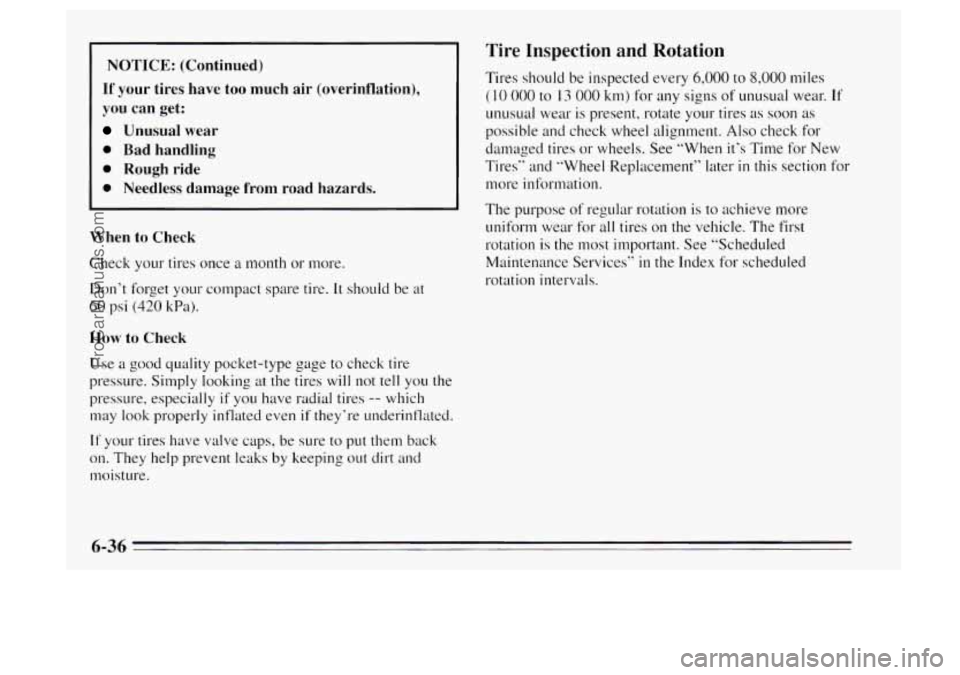wheel alignment OLDSMOBILE AURORA 1995 Owners Manual
[x] Cancel search | Manufacturer: OLDSMOBILE, Model Year: 1995, Model line: AURORA, Model: OLDSMOBILE AURORA 1995Pages: 372, PDF Size: 19.14 MB
Page 266 of 372

NOTICE: (Continued)
If your tires have
too much air (overinflation),
you can get:
Unusual wear
0 Bad handling
0 Rough ride
0 Needless damage from road hazards.
When to Check
Check your tires once a month or more,
Don’t forget your compact spare tire.
It should be at
60 psi (420 kPa).
Use a good quality pocket-type gage to check tire
pressure. Simply looking
at the tires will not tell you the
pressure, especially
if you have radial tires -- which
may look properly inflated even
if they’re underinflated.
If your tires have valve caps, be sure to put them back
on. They help prevent leaks
by keeping out dirt and
moisture.
Tire Inspection and Rotation
Tires should be inspected every 6,000 to 8,000 miles
( 10 000 to 13 000 km) for any signs of unusual wear. If
unusual wear is present, rotate your tires as soon as
possible and check wheel alignment.
Also check for
damaged tires or wheels. See “When it’s Time for New
Tires” and “Wheel Replacement” later
in this section for
more information.
The purpose of regular rotation is
to achieve more
uniform wear for all tires on the vehicle. The first
rotation is the most important. See “Scheduled
Maintenance Services’’
in the Index for scheduled
rotation intervals.
6-36
ProCarManuals.com
Page 270 of 372

Temperature - A, B, C
The temperature grades are A (the highest), B, and C,
representing the tire’s resistance to the generation of
heat and
its ability to dissipate heat when tested under
controlled conditions on
a specified indoor laboratory
test wheel. Sustained high temperature can cause the
material
of the tire to degenerate and reduce tire life, and
excessive temperature can lead to sudden tire failure.
The grade
C corresponds to a level of performance
which all passenger car tires must meet under the
Federal Motor Vehicle Safety Standard
No. 109. Grades
B and A represent higher levels of performance on the
laboratory test wheel than
the minimum required by law.
Warning: The temperature grade
for this tire is
established for a tire that is properly inflated and not
overloaded. Excessive speed, underinflation, or
excessive loading, either separately or in combination,
can cause heat buildup and possible tire failure.
These grades are molded
on the sidewalls of passenger
car tires. While the tires available
as standard
or optional
equipment on General Motors vehicles may vary with
respect to these grades,
all such tires meet General
Motors performance standards and have been approved
for use on General Motors vehicles. All passenger type
(P Metric) tires must conform to Federal safety
requirements
in addition to these grades.
Wheel Alignment and Tire Balance
The wheels on your vehicle were aligned and balanced
carefully at
the factory to give you the longest tire life
and best overall performance.
In most cases, you will not need to have your wheels
aligned again. However, if you notice unusual tire wear
or your vehicle pulling one way or the
other, the
alignment may need to be reset.
If you notice your
vehicle vibrating when driving on
a smooth road, your
wheels may need
to be rebalanced.
ProCarManuals.com
Page 358 of 372

Wheel Alignment
.................................. 6-40
Aluminum .................................. 6-48
CO\;W ReI1loval .............................. 5-23
NutTorque ................................. 5-27
Replacement ................................ 6-41
Window
Lock .................................. 2-30
Windows. Power
............................... 2-29
Windshield
CIea11ing ................................... 6-47
Washer
.................................... 2-32
WasherFluid ................................ 6-22
Wipers ................................ 2-31. 6-59
Winter Driving ................................. 3-23
WreckerTowing ................................. 5-8
Your Driving and the Road ....................... 4-1
Your Vehicle and the Environment .................. 7-1
9-12
ProCarManuals.com